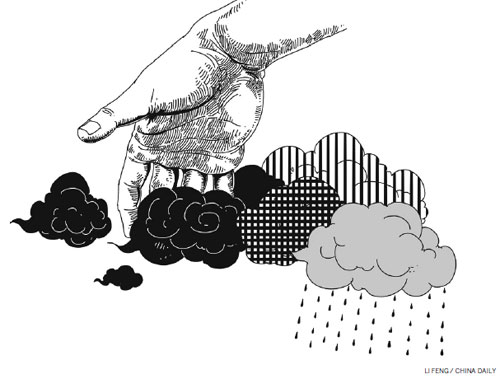Asia-Pacific must drive all-in growth
Asia-Pacific countries continue to drive the global economy. The region has demonstrated great resilience during the economic and financial crisis, contributing about 70 percent of world growth from 2008-2011.
Yet regional growth is now in a challenging phase. The 2014 Economic and Social Survey of Asia and the Pacific, the flagship publication of the United Nations Economic and Social Commission for Asia and the Pacific, forecasts a third successive year of growth below 6 percent in Asia-Pacific developing economies. However, this conceals a wide variation in performance among some major developing economies, ranging from a 7.5 percent growth forecast for China to just 0.3 percent for the Russian Federation in 2014.
Regional growth dynamics are being influenced by the anemic recovery in the developed world given the weak implementation of policy responses. Yet overcoming domestic structural impediments is also vital. Widespread poverty, rising inequality, social inequity and environmental degradation are hurdles to be cleared before the region can set itself on the fast track to high growth which is stable and inclusive.
ESCAP's research highlights new evidence on the nature of these challenges. On the external front, the ongoing normalization of monetary policy by the US Federal Reserve poses continuing challenges for developing Asia-Pacific, but these can be mitigated by stronger macro-prudential policies and flexible exchange rate management. Financial volatility is of concern to India, Indonesia, Malaysia, the Russian Federation, Thailand and Turkey, where annual growth could decline by between 0.7 and 0.9 percent.
If the G20 continues to delay implementation of its standstill commitments on trade protectionism, it will have an impact on the Asia-Pacific region's export growth. Trade restrictions have already deprived the region of an estimated $255 billion in opportunities to exports goods between 2009 and 2013, accounting for more than 1.6 percent of regional GDP.
On the domestic side, growth will remain jobless if countries do not implement labor market programs that effectively align and strengthen education, training and skills with the requirements of employers. From 2009 to 2013, employment grew by only 1.3 percent, compared with average GDP growth of 6.4 percent in developing Asia-Pacific economies.
Without adequate social protection systems, quality education, better access to credit and land, as well as stronger labor market institutions, developing countries will be unable to tackle high and rising inequality. Since the 1990s, regional inequality as measured by the Gini coefficient has risen from 29.9 to 36.8. The wealth of 0.001 percent of the Asia-Pacific population is 17 times greater than the combined GDP of 12 least developed countries in the region.
Fast-tracking the closure of physical infrastructure gaps and social development deficits will augment the region's growth potential. About $800-900 billion of annual investments are needed for national and cross-border infrastructure in transport, telecommunications, energy, water and sanitation.
Demands for social protection remain unmet. Almost half the countries in the region spend less than 2 percent of GDP on social protection, covering only about 40 percent of the population. Environmental degradation is already taking a toll on growth, as evidenced by the estimated environmental cost to India of almost 6 percent of its GDP. Another priority for ensuring the sustainability of growth is to better address climate change through more progressive implementation of climate adaptation and mitigation measures.
Enhancing productive and counter-cyclical spending is critical to offer short-term stimulus and to remove domestic structural constraints. It is also vital for making growth more inclusive and environmental-friendly.
Unlocking fiscal space calls for strengthening of tax revenues. In several countries in the region, tax-to-GDP ratios are near single digits. By way of comparison, this ratio ranges from 25 to 35 percent or more in developed countries.
The good news is that tax-to-GDP ratios can be raised. In many Asia-Pacific countries, the gap between potential and actual tax collection is more than 5 percent of GDP. Closing existing tax gaps in 16 developing Asia-Pacific economies could increase revenues by more than $300 billion, boosting tax revenues by more than 70 percent in some countries. Key among the measures to strengthen tax revenues is broadening the tax base, rationalizing tax rates and careful sequencing of tax reforms.
Since domestic tax revenues, too, are affected by policies in other countries, greater regional cooperation and strengthening of national tax administration can help boost revenues by curbing tax evasion, among others. Asia-Pacific developing countries accounted for more than 60 percent of the $5.9 trillion of global illicit capital outflows between 2001 and 2010.
An Asia-Pacific tax forum, to coordinate regional action on these concerns is therefore, an idea that deserves prompt attention. As the largest and most inclusive intergovernmental forum for Asia-Pacific countries, ESCAP is well positioned to host to such a body.
Creating the fiscal space for productive and counter-cyclical spending can help developing countries in the region move toward implementing the G20 global growth compact adopted last year. This is needed to accelerate progress toward the United Nations Millennium Development Goals and set developing countries on course to implementing the post-2015 development agenda whose depth and breadth moves beyond that of the MDGs.
The author is an under-secretary-general of the United Nations and executive secretary of the Economic and Social Commission for Asia and the Pacific. She is also the UN's Sherpa for the G20 and previously served as governor of the Central Bank of Pakistan and vice-president of the MENA Region of the World Bank.



















